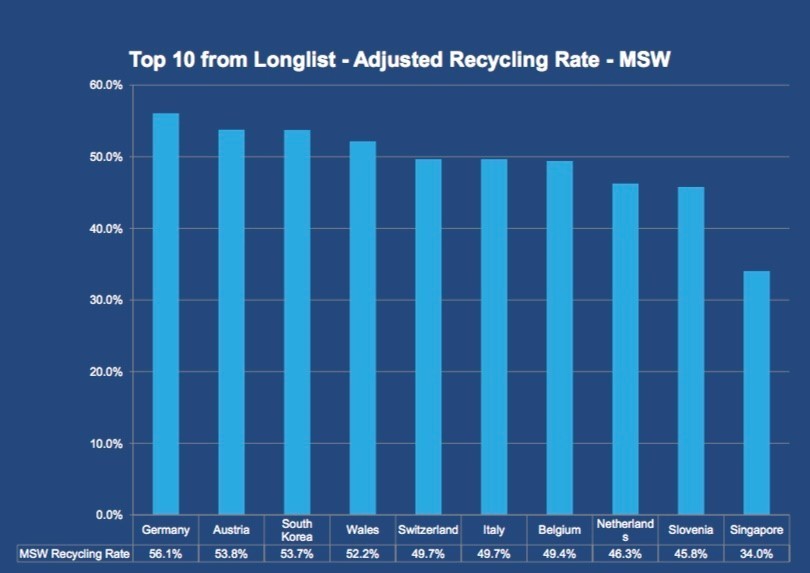Germany recycles more than any other country

But Wales, a 'global leader' in recycling, could outperform Germany as early as 2018. Image: REUTERS/Chris Wattie

Get involved with our crowdsourced digital platform to deliver impact at scale
Stay up to date:
Circular Economy
Germany has the best recycling rate in the world. Austria comes in second, followed by South Korea and Wales. All four countries manage to recycle between 52% and 56% of their municipal waste. Switzerland, in fifth place, recycles almost half of its municipal waste.

According to Eunomia, the environmental consultancy that compiled the report, these countries all have in common government policies that encourage recycling, such as making it easy for households to recycle waste; good funding for recycling; and financial incentives. They also set clear performance targets and policy objectives for local governments.
Some countries, such as Wales, have ambitious recycling targets. Wales aims to achieve zero waste by 2050, and the EU is looking at adopting a new target for 2030, thought to be at least 65%.
The report singles out Wales, which it says outperforms many larger European countries because of its “political leadership and investment”. It says that Wales is a “global leader” in recycling and could outdo Germany, as early as 2018.

The real recycling leaders
Recycling just over half of household waste may seem quite a low rate, but Eunomia says that reported recycling rates have been overstated.
For instance it has been reported that Sweden recycles almost all of its waste. But Eunomia says that’s only because the country counts energy recovery from waste incineration as a form of recycling, which it says is out of step with how the term “recycling” is generally used.
Singapore says that it recycles over 60% of its waste, but Eunomia calculated that much of this was actually commercial and industrial waste, and downgraded its total to 34%.
And as the chart below shows, countries’ reported recycling rates are much higher than in the first league table which Eunomia adapted to take into account the various ways in which recycling is measured.

Even Wales, which does well overall, includes significant amounts of rubble in its recycling rate, despite it not being consistently counted as a type of municipal waste across Europe. Wales had a reported rate of 64%, which Eunomia downgraded to 52%.
Commenting on the findings, report author and managing consultant at Eunomia Rob Gillies said: “It’s important to note this research has been carried out so we can identify who the real leaders in recycling are, to share best practice by shining a spotlight on what these countries are doing."
The report says that it is trying to compare municipal waste recycling rates on as equal a footing as possible, and calls for common definitions for municipal waste and recycling among countries.
“We also hope that this will help progress the debate on how best to measure ‘real’ recycling, in line with the principles of the waste hierarchy, in a way that is as consistent as possible within Europe and further afield,” Gillies said.
What happens to recycled waste?
A huge amount of recycling ends up being shipped to Asia. But China, the world’s largest importer and recycler of scrap metals, plastic and paper, has decided it will no longer take what it calls “foreign garbage”, and is set to ban imports of 24 types of waste.
And this may force industrialized countries to recycle more of their own waste.

Currently Europe recycles 30% of its plastics, compared to just 9% in the United States, but the majority of plastic waste still winds up in landfills and in the oceans.
Don't miss any update on this topic
Create a free account and access your personalized content collection with our latest publications and analyses.
License and Republishing
World Economic Forum articles may be republished in accordance with the Creative Commons Attribution-NonCommercial-NoDerivatives 4.0 International Public License, and in accordance with our Terms of Use.
The views expressed in this article are those of the author alone and not the World Economic Forum.
Related topics:
The Agenda Weekly
A weekly update of the most important issues driving the global agenda
You can unsubscribe at any time using the link in our emails. For more details, review our privacy policy.
More on Circular EconomySee all
Johnny Wood
April 18, 2024
Johnny Wood
April 15, 2024
Pernelle Nunez and Jelena Aleksić
February 6, 2024
Henrik Hvid Jensen
February 1, 2024
Alfred Stern
January 17, 2024
Jelena Aleksić
January 17, 2024






